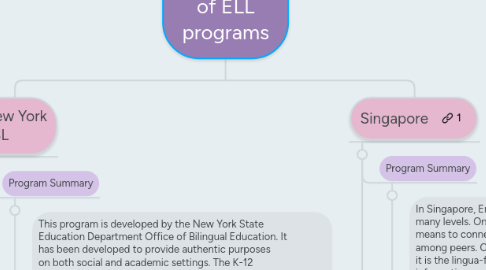
1. New York ESL
1.1. Program Summary
1.1.1. This program is developed by the New York State Education Department Office of Bilingual Education. It has been developed to provide authentic purposes on both social and academic settings. The K-12 program is divided into different groups according to expectations and similarities between grade levels. These groups are divided as follows: Early Childhood (PreK-1), Elementary Grades (2-4), Intermediate Grades (5-8), and Commencement Grades (9-12). In each group, each of the standards incorporates all four language skills, which are reading, writing, listening, and speaking. Each standard focuses on what these four language skills are used for, such as analysis, comprehension, or social interaction. In addition to the four language skills, developing cultural awareness is also interwoven in all of the standards. The NYS ESL program considers their standards to be unique, “in that they: 1) include collaboration, learning strategies, and self-monitoring strategies as indicators of meeting the standard, 2) account for all levels of language proficiency, 3) incorporate knowledge and skills from earlier grade levels into performance indicators of higher grade levels, 4) capitalize on the linguistic and cultural diversity of student population, 5) highlight language features of English essential for second language learners, 6) make explicit nonverbal and paralinguistic features of communication, 7) promote culturally appropriate communicative competence, 8) utilize the students’ native language”. (pg. 13, Introduction)
1.2. Standards
1.2.1. LSRW for information and understanding
1.2.1.1. Teaching reading skills like skimming, highlight, key words, etc.
1.2.2. LSRW for literary response, enjoyment, and expression
1.2.2.1. Engage students in drama
1.2.3. LSRW for critical analysis and evaluation
1.2.3.1. Exploring alternative ways of saying things
1.2.4. LSRW for classroom and social interaction
1.2.4.1. Write friendly notes to friends in English
1.2.5. Cross-cultural knowledge and understanding
1.2.5.1. Compare and contrast folktales from different cultures
2. Singapore
2.1. Program Summary
2.1.1. In Singapore, English is seen as important on many levels. On a local level, it serves as a means to connect different cultures and ideas among peers. On a larger, more global level, it is the lingua-franca that allows access to information and facilitates economic exchanges. English is thus seen as a way to access information and stay current with world affairs. The overall aim of the program is to develop effective language use, to develop an enjoyment of the language in lower and middle primary levels before exposing students to more formal language and activities in high school. The English Language Syllabus for Singapore also lays out very clearly processes and guidelines for their teachers. The six principles of EL Teaching and Learning include: 1) contextualization, 2) learner-centeredness, 3) learner-focused interaction, 4) integration, 5) process orientation, and 6) spiral progression. The teaching processes listed also include raising awareness, structuring consolidation, facilitating assessment for learning, enabling application, guiding discovery, and instructing explicitly. Overall, the program is a well-knit unit of learner outcomes that encompass all language skills, learner attitudes and behaviors, and learning strategies; also incorporating the teacher as an important part of the student’s progress in language development.
2.2. Syllabus Aims
2.2.1. Receptive Skills
2.2.1.1. Listen
2.2.1.2. Read
2.2.1.3. View
2.2.1.4. engage in Social and Emotional learning
2.2.1.5. gain cultural understanding and National education themes
2.2.1.6. Provide a variety of material, especially songs,chants, audio - and encourage active listening skills
2.2.2. Productive Skills
2.2.2.1. Speak
2.2.2.2. Write
2.2.2.3. Represent
2.2.2.3.1. ideas are shown by utilizing multimodal texts and text forms
2.2.2.4. for creative, personal, academic, and functional purposes
2.2.2.5. Provide differentiated material for writing, such as sentence starters, fill in the blanks, etc.
2.2.3. Knowledge about Language
2.2.3.1. Understand
2.2.3.2. Use
2.2.3.2.1. explicit
2.2.3.2.2. meaningful
2.2.3.2.3. enganging
2.2.3.3. Bring in (or meet via internet) special guest speakers to interact with the students
2.2.3.4. Provide students time to think to express themselves
2.2.3.5. Play games that encourage the use of appropriate grammar, intonation, etc.

